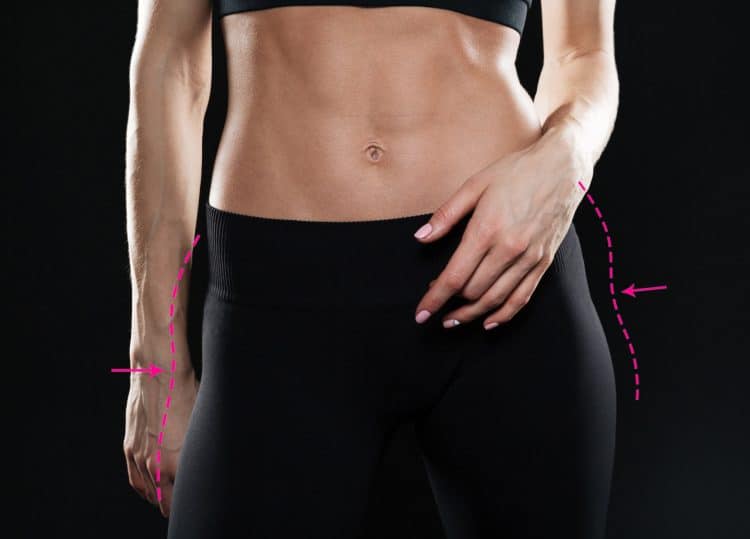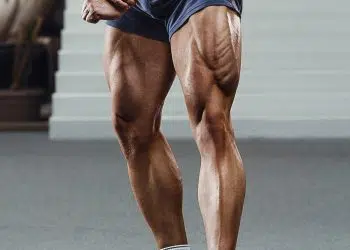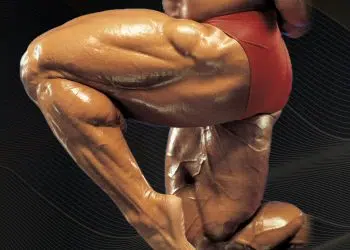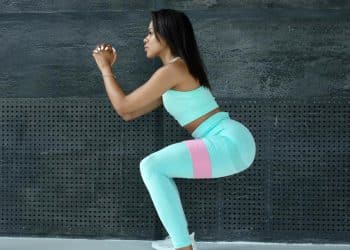Modern women are under tremendous pressure to conform to certain physical ideals. Social media and some celebrities say you MUST have certain physical characteristics to be considered attractive.
Subsequently, many women try to be lean but curvy, toned but not masculine, and have thigh gaps without having skinny legs – so many impossible contradictions!
Of course, some people DO achieve these standards. Still, it’s usually because of favorable genetics, extreme diets, obsessive exercise programs, or drugs and surgery. For the average woman, these ideals are impossible to achieve, and pursuing them is a road to heartache and failure.
The latest thing that women have been told to worry about is hip dips.
Celebrities and social media influencers have jumped on the hip dip bandwagon and are promoting solutions to fix hip dips.
Unfortunately, hip dips are another so-called problem that is just a genetic feature that makes you who you are. People are trying to fix an unfixable problem!
Level Up Your Fitness: Join our 💪 strong community in Fitness Volt Newsletter. Get daily inspiration, expert-backed workouts, nutrition tips, the latest in strength sports, and the support you need to reach your goals. Subscribe for free!
So, in this article, we reveal the cause of hip dips and the exercises you can do to strengthen and shape your hips so you can look and feel your best.
So, What Are Hip Dips, Anyway?
Hip dips, also known as violin hips, is the term used to describe how some women’s hips have an inward curve near the tops of their thighs. According to social media, hip dips are undesirable, and having hip dips makes you less attractive. As a result, many women are looking for ways to fix their hips dips, including special workouts and diets.
In reality, hip dips are the result of your skeletal structure and genetics – you were either born with hip dips, or you weren’t.
Your hips are made up of the union or coming together of several bones, including your ilium, ischium, pubis, and femurs. All of these bones can be any number of different sizes and shapes. As such, the hips are subject to a huge amount of variability from person to person (1).
Some people have wide hips, and others have narrow hips. Some people have a deep pelvis, while others have a shallower pelvis. Some people have outward-curving hips, while others have hip dips.
These variations even have clinical names:

Your hip dip (or lack thereof) is determined by your bone structure, and there is nothing you can do to change it. If hip dips were caused by weak or underdeveloped muscles, like a flat butt, you could train them away or at least make them less noticeable.
But they aren’t, so you can’t.
Therefore, if some social media personality doesn’t have hip dips, it’s not because of their diet or workout program. Instead, it’s because of their parents, and whatever else they tell (or sell) you is false.
You can, however, perform exercises that improve the general shape, strength, and stability of your hips so they look and feel their best.
Exercises for Hip Dips
Just in case you skipped the last section, it’s important to reiterate that you can’t fix hip dips with exercises. Hip dips are a genetic trait resulting from the structure of your pelvis and hips. You can no more fix your hip dips with exercise than you can train your eyes to change color.
However, there are plenty of GREAT exercises you can do for your hip complex that will help keep it strong, stable, and functioning correctly. So, here is a selection of our favorite exercises for the hips!
1. Booty band hip thrusts
If you only do one exercise for your hips, this should probably be it. The booty band hip thrust works all your glute muscles simultaneously, making it a very efficient and functional exercise. 2-4 sets of 12-20 reps will light up your glutes and strengthen your entire hip complex. Do it – you’ll love it!
Steps:
- Put your booty band around your legs, just below your knees.
- Sit on the floor with your back against a sturdy exercise bench. Bend your legs and plant your feet firmly on the floor.
- Drive your feet into the floor and push your hips up while simultaneously pressing your knees apart.
- At the top of the rep, your knees, hips, and shoulders should form a straight line.
- Lower your butt back to the floor and repeat.
Tips:
- You can also do this exercise isometrically, i.e., holding the top position for time.
- Rest and hold a weight on your hips to make this exercise harder.
- You can also do this exercise without a bench like this:
2. Sumo deadlifts
The sumo deadlift is much more hip-centric than the conventional variation. The wide stance means you must press your feet and knees outward, and hinging forward ensures your glutes get a great workout. Deadlifts deserve a place in almost every workout, but sumos are arguably best for building stronger hips.
Steps:
- Standing behind your barbell, take a wide stance so your feet are close to the weight plates. The bar should be almost touching your shins. Turn your toes out slightly.
- Hinge forward and hold the bar with a shoulder-width mixed grip. Your back should be slightly arched, core braced, arms straight, shoulders down and back, and hips higher than your knees.
- Without rounding your lower back, drive through your heels and midfoot and extend your knees, keeping the bar close to your legs.
- Push your hips forward and tense your glutes to finish off the movement. Do not lean back or attempt to bend your arms, as doing so could cause serious injury.
- Return the weight to the floor, allow the weight to settle for a second, and repeat.
Tips:
- Use a double overhand grip if preferred.
- Use chalk or lifting straps to reinforce your grip.
- You can also do this exercise with a single kettlebell, like this:
3. Cable pull-throughs
A lot of hip exercises also put stress on your lower back. The cable pull-through hits your hips hard but is easy on your lumbar spine. Make this your go-to hip exercise if you suffer from lower back pain.
Steps:
- Attach a rope handle to a low pulley.
- Stand with your back to the machine with your feet astride the handle and slightly wider than shoulder-width apart.
- Lean over to grab the handle with both hands. Stand up and take a couple of steps forward to load the cable. Brace your abs and pull your shoulders down and back.
- Push your hips back and lean forward, reaching backward between your legs. Do not round your lower back.
- Drive your hips forward and stand back up, locking your knees and tensing your glutes as you reach the top of your rep.
- Hinge forward again and repeat.
Tips:
- You can also do this exercise with a resistance band.
- Experiment with the width of your feet to find the best position for working your hips and glutes. Wider is often better.
- Pause at the top of each rep and contract your glutes as hard as possible to make this exercise even more effective.
4. Reverse deficit lunges
Most people know that lunges are a great leg exercise. Still, they’re an even better hip exercise, especially when you do them off a raised platform. Lunges involve hip flexion and extension, but you also need to use your abductors or outer hips to stabilize your legs. This makes them a very effective and efficient lower body exercise.
Steps:
- Stand on a raised platform, such as a bumper plate or an aerobic step box top.
- Take a large step back, bend your legs, and lower your rear knee down toward the floor. Make sure you descend to below the level of your front foot.
- Push off your rear leg and bring your feet back together on the platform.
- Switch legs and repeat.
Tips:
- The higher the platform, the larger your range of motion, and the more challenging this exercise becomes.
- Hold dumbbells to make this exercise harder.
- Lean forward slightly to increase glute and hamstring engagement.
5. Side-lying leg lift
This is one of the exercises some fitness influencers say will fill in your hip dip. Sadly, they are mistaken, as the dip results from bone formation and not a lack of muscle mass. However, this exercise WILL strengthen the outside of your hips and glutes, increasing hip stability.
Steps:
- Lie on your side with your legs straight, hips and shoulders stacked, and your head resting on your outstretched arm. Brace your abs.
- Keeping your knee straight, lift your uppermost leg to around 45 degrees. Do not lean backward.
- Lower your leg back down and repeat.
- Roll over and do the same number of reps on the opposite side.
Tips:
- Lean forward slightly and point your toes down toward the floor to increase glute engagement.
- Use ankle weights or a resistance band to make this exercise more challenging.
- Bend your bottom leg if it makes the exercise more comfortable.
6. Plie squat
All squats work your hips, but the wide-stance plie squat works your hips harder. This is also an excellent exercise for your inner and outer thighs. It can be done with or without weights as preferred.
Steps:
Level Up Your Fitness: Join our 💪 strong community in Fitness Volt Newsletter. Get daily inspiration, expert-backed workouts, nutrition tips, the latest in strength sports, and the support you need to reach your goals. Subscribe for free!
- Stand with your feet about 1 ½ shoulder-widths apart. Turn your toes outward to about 45 degrees. Pull your shoulders down and back, and brace your core. Look straight ahead.
- Bend your knees and squat down until your thighs are roughly parallel to the floor. Push your thighs outward as you descend.
- Drive your feet into the floor and stand back up. Squeeze your glutes at the top of each rep.
- Repeat for the desired number of reps.
Tips:
- Imagine you are pushing your feet apart to maximize hip engagement.
- You can do this exercise with a barbell on your back, dumbbells in your hands, or holding a weight in front of your chest, e.g., a kettlebell or a single dumbbell.
- Rise up onto your toes between reps to also work your calves.
7. Fire hydrants
This is another so-called hip dip fixer! While this move does target the area where your hip dip is located, it won’t magically fill it in. However, the fire hydrant will strengthen your hips and improve hip stability and health. As for the name, it’s because you look like a dog taking a sneaky leak – sorry about that!
Steps:
- Kneel on all fours with straight arms, hands under your shoulders, and knees under your hips. Brace your abs.
- Shift your weight onto one knee, open your hips, and lift the other leg up and out to the side. Keep your knee bent throughout. Pause with your leg raised for two seconds.
- Lower your leg and repeat.
- Rest a moment and then swap sides.
Tips:
- You can also do this exercise by resting your forearms on the floor.
- Do not twist your hips or shoulders during this exercise.
- Wear ankle weights or use a resistance band to make this exercise harder.
8. Cable hip abductions, adductions, and extensions
If you have access to a low cable machine and a suitable ankle strap, you have everything you need to work your hips from all the angles. These three exercises ensure that your hips are strong in all directions. Do one set of each exercise on one leg before swapping sides.
Steps:
- Put the ankle strap on and attach it to a low cable machine. Stand side-on to the machine with the leg you want to train outmost.
- Using your arms for support if required, lift your leg up and out to the side to around 45 degrees. Lower it back down and repeat for the desired number of reps.
- Next, turn and face the other way, so the leg you want to work is innermost. Draw your leg across and in front of your midline as far as possible. Return to the starting position and repeat.
- Finally, turn and face the machine. Extend your leg out behind you, taking care not to hyperextend your lower back. Lower your leg and repeat.
- Rest a moment, switch legs, and repeat the three-exercise sequence on the other side.
Tips:
- You can do all three exercises with a resistance band.
- No ankle strap? Try putting your foot inside a D-shaped handle.
- You don’t have to do all three exercises. Instead, use the ones that are most appropriate to your exercise goals.
9. Booty band squat
You already know that squats are a good hip exercise, but they’re even better when you do them with a booty band. Squatting with a resistance band around your knees forces you to actively abduct your hips, which increases muscle engagement. You feel this exercise right in the area of your hip dips, but sadly, it won’t make them vanish!
Steps:
- Put your booty band around your legs, just above or just below your knees. Stand with your feet about shoulder-width apart, toes turned slightly outward. Push your knees out against the resistance offered by the band.
- Bend your legs and descend until your thighs are roughly parallel to the floor. Do not round your lower back.
- Stand back up and repeat.
Tips:
- You can do this exercise with or without weights as required.
- Maintain outward pressure against the band to maximize hip engagement.
- You can also do this exercise with a yoga strap or even a belt if you don’t have a booty band.
10. Single-leg Romanian deadlift
All single-leg exercises are good for improving hip strength and stability. That’s because when you balance on one leg, you need to use the hips on the supporting side to stop you from falling sideways. Single-leg Romanian deadlifts are a popular glute and hamstring exercise, but they’re just as good for your hips.
Steps:
- Stand with your feet together, arms by your sides. Shift your weight over onto one leg. Bend your supporting knee slightly for balance. Pull your shoulders down and back, and brace your core.
- Hinging from your hips, lean forward and reach down toward the floor. Go as far as you can without rounding your lower back. Extend your non-working leg out behind you to act as a counterbalance.
- Stand back up and repeat.
- Switch legs and do the same number of reps on the opposite side.
Tips:
- Do this exercise next to a wall and use it for balance if necessary.
- You can also do this exercise with one or two dumbbells or kettlebells.
- Keep your non-working foot on the floor for balance if needed, which is called a kickstand Romanian deadlift:
FAQs
Got a question about hip dips or the exercises in this article? That’s okay because we’ve got the answers!
1. So, hip dips are normal, right?
That’s right, it’s completely normal to have hip dips, although some people don’t have them. Your hip dips, or lack thereof, are determined by your bone structure. And while you may be able to reduce them slightly by focusing on your outer hip and glute muscles, there really isn’t much you can do to eliminate them.
Don’t like having hip dips? Sadly, there is not much you can do about it except have surgery to fill them in with redistributed fat, which is called liposculpting. It would be better to accept how you look.
2. What’s the difference between hip dips and saddlebags?
Hip dips describe an inward curve at the tops of your thighs, while saddlebags are an outward curve caused by an accumulation of body fat.
In the same way that you can’t fix hip dips with targeted exercises, you won’t be able to melt fat away to get rid of your saddlebags, either. Instead, you’ll need to lose fat from all over your body, and it’ll eventually vanish from your hips too.
You can read more about saddlebags here.
3. What is the best diet for hip dips?
Anyone who tells you are is a specific diet that will fix hip dips is either mistaken or purposely lying to you. Suggesting that eating a certain way will change your bone structure is wrong and akin to telling you that there is a diet that’ll make you taller or your feet grow!
Your hip dips are the result of genetics, and all you can do is learn to love and live with them.
4. Some media personalities have diets and workout programs to fix hip dips – do they work?
Hip dips are a made-up problem, and before a short time ago, no one even knew it existed. Then, a few social media influencers noticed that some people had them while others did not and decided to make a big deal out of hip dips.
Either mistakenly or by design, the influencers determined that their lack of hip dips resulted from their diet and exercise program and that hip dips were preventable and fixable. They also suggested that what is essentially a genetic trait played a part in what made people attractive.
As a result, many women have been fooled into thinking that a) hip dips aren’t normal and b) something needs to be done to fix them.
This is a perfect example of how social media can be misleading and cause more harm than good.
5. If hip dips are normal, what is the point of doing hip exercises?
Your hips are a complex, hard-working joint. They’re cable of supporting huge loads and can perform a wide range of motion. As such, there is a lot that can go wrong with the hips, and doing hip exercises can help keep them in tip-top shape.
Strong, mobile, stable hips are less prone to aches, pains, and injuries. Given how many movements start and end with the hips, it makes perfect sense to train this part of your body.
So, don’t do hip exercises to fix your hip dip. Instead, exercise your hips to keep them healthy and strong.
6. How often should I train my hips?
While exercise is good for your hips, you can have too much of a good thing. There is no need to train your hips obsessively, and doing too much could actually lead to overtraining.
Work your hips 2-3 times per week as part of your lower body workout. Make sure you include several different exercises to address all the major hip functions. The exercises in this article, divided into 2-3 workouts, is an excellent place to start.
For more on hip training, check out these articles:
- Glues Ahoy! The Bigger Hips Workout
- Best Hip and Butt Exercises
- Best Stretches for Flexible, More Mobile Hips
Hip Dips – Closing Thoughts
Social media influencers must keep coming up with new content to stay relevant. Sometimes that means inventing problems just so they can sell you the solution. That’s what happened with hip dips.
The shape of your hips is determined by the structure of your pelvis, and no amount of training or dieting will change that. Trying to fix the unfixable is a waste of time and energy and can lead to feelings of unhappiness with what is otherwise a perfectly normal appearance.
So, don’t let influencers tell you how you should look. Most of them cannot achieve their own ideals. Instead, just be the best you that you can be and focus on being fit and healthy. There is no need to worry about your hip dips or lack of them. They’re just how you were made!
References:
Raoofi, S., Takian, A., Sari, A. A., Olyaeemanesh, A., Haghighi, H., Aarabi, M., & Arab-Zozani, M. (2019). Health sector evolution plan in Iran; equity and sustainability concerns. International journal of health policy and management, 8(10), 571-576. https://doi.org/10.15171/ijhpm.2019.42









